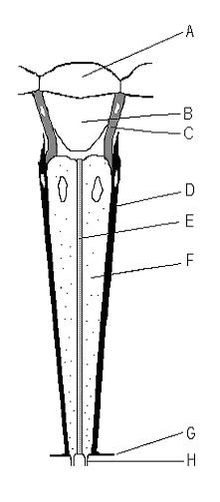Ommatidium
Ommatidia (from late Greek. Ommatidion = "little eye ") are the individual eyes that make up the compound eyes of the arthropods , including the insects and crustaceans . Depending on the species, a compound eye consists of only individual to many thousands of ommatidia, in dragonflies, for example, up to 28,000 individual eyes .
An ommatidium is formed from five to nine (in the mandibulata always eight) sensory cells (in Figure F), the microvilli borders ( rhabdomere ) of which point towards the axis and form the rhabdom (E). The outwardly adjoining supporting and pigment cells separate the individual ommatidia from one another. The outer part of the ommatidium is a dioptric device , which is formed from a transparent, highly refractive corneal lens (A), which is adjoined below by crystal cells or a crystal cone (B). On the underside of the individual eye, the electrical nerve impulses are passed on to the brain via an axon of a nerve cell .
The cornea is formed by the cells known as corneagen cells in crustaceans and as main pigment cells in insects, which adjoin the ommatidia. In the case of the mandibulata , a crystal cone originally formed from 4 cells is also formed for further refraction of light. If the crystal cone is placed inside the cells, it is called a eukon; if the crystal cone is placed outside the cells, it is called pseudocon. Ommatidia without crystal cones within insects are aconous, and in some species of beetles with a cone- like extension of the cornea that takes on the function of crystal cones, ommatidia are called exoconic.
Tribal history
The ommatidia and the compound eyes connected with it are regarded as ancestral characteristics for the original Euarthropoda . They can be found in the extinct trilobites as well as in recent insects, Myriapoda and crustaceans. In the arachnids , the centipedes and the bipedes , the compound eyes are broken up into single eyes, which correspond in structure to modified ommatidia. The belonging to the centipedes spiders runners ( Scutigera ), there was a renewed merging of these Einzelommatidien to so-called pseudo compound eyes.
supporting documents
- Hannes Paulus: Euarthropoda, Arthropod, ieS In: W. Westheide, R. Rieger (Ed.): Special Zoology. Part 1: Protozoa and invertebrates. Gustav Fischer Verlag, Stuttgart / Jena 1997, ISBN 3-437-20515-3 .
- Herder Lexicon of Biology. Spektrum Akademischer Verlag, Heidelberg 2003, ISBN 3-8274-0354-5 .
